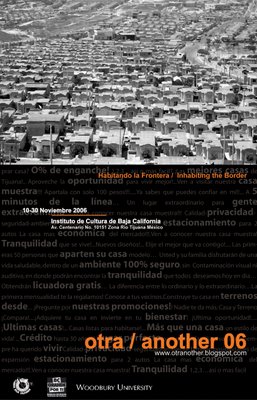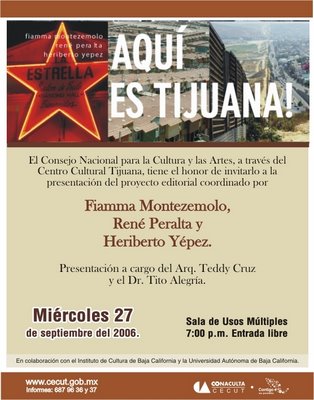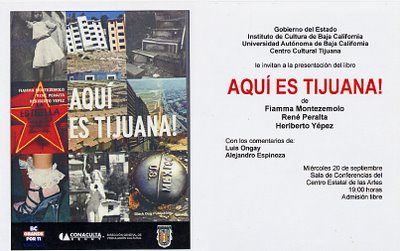Month: September 2006
Ayer se presento Aqui es Tijuana en el Centro Estatal de las Artes en Mexicali. Con un buen numero de publico y los presentadores Cachanillas Luis Ongay y Alejandro Espinosa (que se les agradece por su participación).
Se me quedan muy marcadas dos cosas; una la constante critica de ver esta publicación como un compendio final, como una mirada absoluta y tal ves una metodología pseudo académica. Para los presentadores es una representación(es) o “snapshots” de los clichés tijuaneneses de los últimos años, un libro dentro de aquellos que tienen un “shock value” como su primera intención – a tal grado que uno de los presentadores narra que Tijuana – le da miedo. Dentro el segundo comentario Aquí es Tijuana es el final de la Tijuanologia – me imagino que se refiere a la incesante flujo de imágenes, textos, libros y exposiciones sobre esta ciudad en los últimos años. Pero en lo personal Aquí es Tijuana intenta hacer un recuento del tiempo-espacio de lo intrico que son la relaciones sociales y urbanas de una ciudad al final del sigloXX. Si como dice Christopher Alexander “ a city is not a tree” entonces es rizoma, raíz – un entrelace del event-space. Y si hay algo en común entre los tres autores – es la idea que Tijuana es un ensamble de correlaciones intricas al nivel antropológico, mental y urbano que se desenvuelve en un estado psicogeografico, una ficcion, una tragedia, una comedia – a bad trip- . Tijuana siempre cree que es otra – por que nunca puede ser Tijuana. It’s too scary.
Al final la pregunta mas comprometedora de la noche fue – ya que conoces Tijuana y si tuvieras una imagen de Mexicali cual fuera? Conteste “La Romurosa”.
Ayer se presento Aqui es Tijuana en el Centro Estatal de las Artes en Mexicali. Con un buen numero de publico y los presentadores Cachanillas Luis Ongay y Alejandro Espinosa (que se les agradece por su participación).
Se me quedan muy marcadas dos cosas; una la constante critica de ver esta publicación como un compendio final, como una mirada absoluta y tal ves una metodología pseudo académica. Para los presentadores es una representación(es) o “snapshots” de los clichés tijuaneneses de los últimos años, un libro dentro de aquellos que tienen un “shock value” como su primera intención – a tal grado que uno de los presentadores narra que Tijuana – le da miedo. Dentro el segundo comentario Aquí es Tijuana es el final de la Tijuanologia – me imagino que se refiere a la incesante flujo de imágenes, textos, libros y exposiciones sobre esta ciudad en los últimos años. Pero en lo personal Aquí es Tijuana intenta hacer un recuento del tiempo-espacio de lo intrico que son la relaciones sociales y urbanas de una ciudad al final del sigloXX. Si como dice Christopher Alexander “ a city is not a tree” entonces es rizoma, raíz – un entrelace del event-space. Y si hay algo en común entre los tres autores – es la idea que Tijuana es un ensamble de correlaciones intricas al nivel antropológico, mental y urbano que se desenvuelve en un estado psicogeografico, una ficcion, una tragedia, una comedia – a bad trip- . Tijuana siempre cree que es otra – por que nunca puede ser Tijuana. It’s too scary.
Al final la pregunta mas comprometedora de la noche fue – ya que conoces Tijuana y si tuvieras una imagen de Mexicali cual fuera? Conteste “La Romurosa”.
Here is Tijuana. Fiamma Montezemolo, Rene Peralta, Heriberto Yepez.
London: Black Dog Publishing, 2006.
(Book Review)
Tarek Elhaik
Visiting Assistant Professor
Department of Anthropology
Rice University
As one leafs through the visually rich pages of HERE IS TIJUANA one cannot miss both the sovereign attempt to represent a City and the setting in motion of the irony and limit of that very effort. It brings the very Benjaminian notion of a gesture to bear upon the set of difficulties and perverse pleasures that arise from this remarkable effort to grapple with, visually and discursively, such an intense collective space of enunciation as Tijuana.
The multiplicity of images range from everyday public life practices to the hustle-and-bustle of street and nightlife to aerial photos of biopoliticized housing projects to site-specific art interventions to the more intimate interior spaces of bars, pubs and dance halls. The book is briefly introduced as a collective project in the prologue by the authors who reappear in the form of cameo appearances disseminated amidst citations, statistical data, and images that over the years have caught their attention and curiosity.
The post-9/11 US-Mexico border City appears both as a biopoliticized entity and an object of affection, at once impersonal and personal. By weaving thus visually pleasing and jarring material, Montezemolo (the Anthropologist), Peralta (the Architect) and Yepez (the Philosopher)—friends and scholars of different academic trainings and backgrounds —have managed a tour de force by gesturing towards non-academic and non-analytical forms to engage and organize anthropological, urban, architectural, literary, artistic and theoretical material. On the surface of carefully selected and point-and-shoot images, one ‘senses’ not so much the celebration of a polyphonic city in the throes of chaos, but the beginning of a tender and affectionate laughter one directs at oneself, at one’s native city or research site, and at the impossibility of such representational strategies as visual polyphony.
The book is a fantastic treat for visual anthropologists, anthropologists of art, visual artists, architects and readers from all walks of life who delight in the omnivorous pleasure of reading, gazing at and consuming images in travel agencies, seminar rooms, site-specific interventions or gallery art installations. Or simply as they sit on a toilet bowl or drink coffee on a boring Sunday morning. Far from the pretensions one often finds in historicizing attempts of the conventional cultural-visual histories, the gesture of the authors of HERE IS TIJUANA contributes and extends the raison d’etre of a much more provocative attitude: that of the Dadaists who made it a playful bad habit of getting together with friends in order to exquisitely and creatively kill boredom. That and much more is one of the merits of this fantastic interdisciplinary and collective experiment that, for the purposes of anthropology at least, blurs the boundaries of ‘visual anthropology’ and ‘anthropology of art’, and surely will inspire anthropologists to embark on collective projects not only at ease with images but that also make art.
Here is Tijuana. Fiamma Montezemolo, Rene Peralta, Heriberto Yepez.
London: Black Dog Publishing, 2006.
(Book Review)
Tarek Elhaik
Visiting Assistant Professor
Department of Anthropology
Rice University
As one leafs through the visually rich pages of HERE IS TIJUANA one cannot miss both the sovereign attempt to represent a City and the setting in motion of the irony and limit of that very effort. It brings the very Benjaminian notion of a gesture to bear upon the set of difficulties and perverse pleasures that arise from this remarkable effort to grapple with, visually and discursively, such an intense collective space of enunciation as Tijuana.
The multiplicity of images range from everyday public life practices to the hustle-and-bustle of street and nightlife to aerial photos of biopoliticized housing projects to site-specific art interventions to the more intimate interior spaces of bars, pubs and dance halls. The book is briefly introduced as a collective project in the prologue by the authors who reappear in the form of cameo appearances disseminated amidst citations, statistical data, and images that over the years have caught their attention and curiosity.
The post-9/11 US-Mexico border City appears both as a biopoliticized entity and an object of affection, at once impersonal and personal. By weaving thus visually pleasing and jarring material, Montezemolo (the Anthropologist), Peralta (the Architect) and Yepez (the Philosopher)—friends and scholars of different academic trainings and backgrounds —have managed a tour de force by gesturing towards non-academic and non-analytical forms to engage and organize anthropological, urban, architectural, literary, artistic and theoretical material. On the surface of carefully selected and point-and-shoot images, one ‘senses’ not so much the celebration of a polyphonic city in the throes of chaos, but the beginning of a tender and affectionate laughter one directs at oneself, at one’s native city or research site, and at the impossibility of such representational strategies as visual polyphony.
The book is a fantastic treat for visual anthropologists, anthropologists of art, visual artists, architects and readers from all walks of life who delight in the omnivorous pleasure of reading, gazing at and consuming images in travel agencies, seminar rooms, site-specific interventions or gallery art installations. Or simply as they sit on a toilet bowl or drink coffee on a boring Sunday morning. Far from the pretensions one often finds in historicizing attempts of the conventional cultural-visual histories, the gesture of the authors of HERE IS TIJUANA contributes and extends the raison d’etre of a much more provocative attitude: that of the Dadaists who made it a playful bad habit of getting together with friends in order to exquisitely and creatively kill boredom. That and much more is one of the merits of this fantastic interdisciplinary and collective experiment that, for the purposes of anthropology at least, blurs the boundaries of ‘visual anthropology’ and ‘anthropology of art’, and surely will inspire anthropologists to embark on collective projects not only at ease with images but that also make art.
Otra – Again

En proceso. pasen al blog de otra/another para mas informacion. el 10 de noviembre los esperamos en el instituto de cultura de baja california.
Otra – Again

En proceso. pasen al blog de otra/another para mas informacion. el 10 de noviembre los esperamos en el instituto de cultura de baja california.
BIG NEWS
Por fin llegaron los ejemplares en español de Aquí es Tijuana. El lunes pase al Centro Cultural a recoger las cajas. A las personas que colaboraron con imágenes por favor pasen a mi oficina por su ejemplar. Estoy en Aguascalientes 2332 Colonia Cacho – a lado de la imprenta victoria.
La presentación oficial se va a realizar en tres sesiones: en Mexicali el día 20 de Septiembre a las 19 horas en la Sala de Conferencias del Centro Estatal de las Artes – en Tijuana el día 26 de Septiembre a las 19 horas en el Centro Cultural Tijuana y el 27 de Septiembre a las 11am en la UABC. El 28 de Septiembre estaré presentando el libro en USC en Los Ángeles (por confirmar).
BIG NEWS
Por fin llegaron los ejemplares en español de Aquí es Tijuana. El lunes pase al Centro Cultural a recoger las cajas. A las personas que colaboraron con imágenes por favor pasen a mi oficina por su ejemplar. Estoy en Aguascalientes 2332 Colonia Cacho – a lado de la imprenta victoria.
La presentación oficial se va a realizar en tres sesiones: en Mexicali el día 20 de Septiembre a las 19 horas en la Sala de Conferencias del Centro Estatal de las Artes – en Tijuana el día 26 de Septiembre a las 19 horas en el Centro Cultural Tijuana y el 27 de Septiembre a las 11am en la UABC. El 28 de Septiembre estaré presentando el libro en USC en Los Ángeles (por confirmar).




